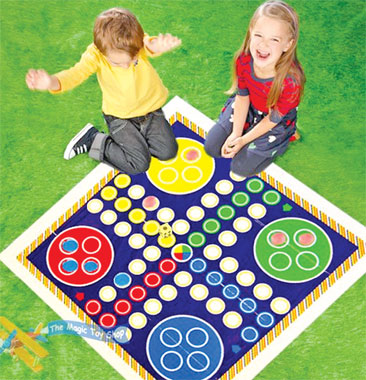Ludo -an interesting board game
In North America, the game is sold under the brand name `Parcheesi'
which means "Man, don't get irritated", and has equivalent names in
Dutch, Croatian, Serbian, Bulgarian, Russian, Slovak, Slovene and
Polish, where it is more commonly referred to as `Chi'. In Greece, this
game is called [Griniaris] ("Grumbler") referring to typical player
behaviour.
 In
Czech its called 'nezlob se' ("Don't be angry, man"). In Sweden it is
known as "Fia", a name derived from the Latin word `fiat' which means
"so be it!" Common variations on the name are "Fia-spel" (Fia the game)
and "Fia med knuff" (Fia with push). In Denmark and Norway though, the
game is known as Ludo. In
Czech its called 'nezlob se' ("Don't be angry, man"). In Sweden it is
known as "Fia", a name derived from the Latin word `fiat' which means
"so be it!" Common variations on the name are "Fia-spel" (Fia the game)
and "Fia med knuff" (Fia with push). In Denmark and Norway though, the
game is known as Ludo.
The Ludo board
Special areas of the Ludo board are typically coloured bright yellow,
green, red and blue. Each player is assigned a colour and has four
tokens of matching colour (originally bone discs but today often made of
cardboard or plastic). The board is normally square with a cross-shaped
`game track', with each arm of the cross consisting of three columns of
squares - usually six squares per column.
The middle columns usually have five squares coloured, and these
represent a player's `home column'.
A sixth coloured square not on the home column is a player's
`starting square'. At the centre of the board is a large `finishing
square' often composed of triangles in the four colours atop the
players' home columns - thus forming "arrows" pointing to the finish.
Rules Overview
Two, three, or four may play. At the beginning of the game, each
player's tokens are out of play and staged in one of the large corner
areas of the board in the player's colour (called the player's `yard' ).
When able to, the players will enter their tokens one per time on
their respective starting squares and proceed to race them clockwise
around the board along the game track (the path of squares not part of
any player's home column).

When reaching the square below the home column, a player continues by
racing tokens up the column to the finish square.
The rolls of a cube dice control the swiftness of the tokens and
entry to the finish square requires a precise roll from the player. The
first to bring all their tokens to the finish wins the game.
The others often continue play to determine second, third and
fourth-place finishers.
Rolls of the dice
Each player rolls the dice, the highest roller begins the game. The
players alternate turns in a clockwise direction.
To enter a token into active play from his staging area to his
starting square, a player must roll a `6'. If the player has no tokens
yet in play and does not roll a `6', the turn passes to the next player.
Once a player has one or more tokens in play, he selects a token and
moves it forward along the track the number of squares indicated by the
die roll. If a player rolls a `6' he may choose to advance a token
already in play, or alternatively, he may enter another of his tokens
into active play.
The rolling of a `6' earns the player an additional ("bonus") roll in
that turn. If the additional roll results in a `6' again, the player
earns an additional bonus roll. If the third roll is also a `6', the
player may not move a token and the turn immediately passes to the next
player. Players must always move a token according to the die value
rolled, and if no move is possible, pass their turn to the next.
A player may not end his move on a square he already occupies. If the
advance of a token finishes on a square occupied by an `opponent's'
token, the opponent token is returned to its owner's yard. The returned
token may only be reentered into play when the owner again rolls a `6'.
(Unlike Pachisi, there are no "safe" squares on the game track which
protect a player's tokens from being returned. A player's home column
squares are always safe, however, since no opponent may enter them. Ludo
played in the Indian subcontinent features a safe square in each
quadrant, normally the fourth square from the top in the rightmost
column. These squares are usually marked with a star.)
Variations
- To get a game started faster, some house rules.
- Allow a player with no pieces on the board to bring their first
piece into play on any roll, on a `1' or a `6', or allow multiple tries
to roll a `6' (with three rolls being the most popular).
- If a piece lands on the same space as the another piece of the same
colour, the moved piece must take the preceding space.
- If a player's piece lands on another of their own pieces, they are
doubled and form a "block" which cannot be passed by any opponent's
pieces.
-Internet |

